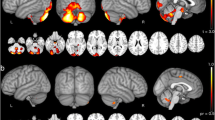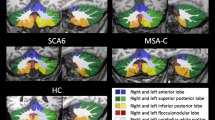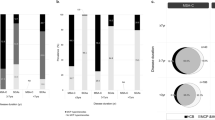Abstract
In this study, we used manual delineation of high-resolution magnetic resonance imaging (MRI) to determine the spatial and temporal characteristics of the cerebellar atrophy in spinocerebellar ataxia type 2 (SCA2). Ten subjects with SCA2 were compared to ten controls. The volume of the pons, the total cerebellum, and the individual cerebellar lobules were calculated via manual delineation of structural MRI. SCA2 showed substantial global atrophy of the cerebellum. Furthermore, the degeneration was lobule specific, selectively affecting the anterior lobe, VI, Crus I, Crus II, VIII, uvula, corpus medullare, and pons, while sparing VIIB, tonsil/paraflocculus, flocculus, declive, tuber/folium, pyramis, and nodulus. The temporal characteristics differed in each cerebellar subregion: (1) duration of disease: Crus I, VIIB, VIII, uvula, corpus medullare, pons, and the total cerebellar volume correlated with the duration of disease; (2) age: VI, Crus II, and flocculus correlated with age in control subjects; and (3) clinical scores: VI, Crus I, VIIB, VIII, corpus medullare, pons, and the total cerebellar volume correlated with clinical scores in SCA2. No correlations were found with the age of onset. Our extrapolated volumes at the onset of symptoms suggest that neurodegeneration may be present even during the presymptomatic stages of disease. The spatial and temporal characteristics of the cerebellar degeneration in SCA2 are region specific. Furthermore, our findings suggest the presence of presymptomatic atrophy and a possible developmental component to the mechanisms of pathogenesis underlying SCA2. Our findings further suggest that volumetric analysis may aid in the development of a non-invasive, quantitative biomarker.




Similar content being viewed by others
References
Manto M-U, Pandolfo M. The cerebellum and its disorders. Cambridge University Press; 2002.
Gispert S, Twells R, Orozco G, Brice A, Weber J, Heredero L, et al. Chromosomal assignment of the second locus for autosomal dominant cerebellar ataxia (SCA2) to chromosome 12q23-24.1. Nat Genet. 1993;4(3):295–9.
Imbert G, Saudou F, Yvert G, Devys D, Trottier Y, Garnier JM, et al. Cloning of the gene for spinocerebellar ataxia 2 reveals a locus with high sensitivity to expanded CAG/glutamine repeats. Nat Genet. 1996;14(3):285–91.
Shibata H, Huynh DP, Pulst SM. A novel protein with RNA-binding motifs interacts with ataxin-2. Hum Mol Genet. 2000;9(9):1303–13.
Viscomi MT, Florenzano F, Amadio S, Bernardi G, Molinari M. Partial resistance of ataxin-2-containing olivary and pontine neurons to axotomy-induced degeneration. Brain Res Bull. 2005;66(3):212–21.
Velázquez-Pérez L, Seifried C, Abele M, Wirjatijasa F, Rodríguez-Labrada R, Santos-Falcón N, et al. Saccade velocity is reduced in presymptomatic spinocerebellar ataxia type 2. Clin Neurophysiol. 2009;120(3):632–5.
Inagaki A, Iida A, Matsubara M, Inagaki H. Positron emission tomography and magnetic resonance imaging in spinocerebellar ataxia type 2: a study of symptomatic and asymptomatic individuals. Eur J Neurol. 2005;12(9):725–8.
Moretti P, Blazo M, Garcia L, Armstrong D, Lewis RA, Roa B, et al. Spinocerebellar ataxia type 2 (SCA2) presenting with ophthalmoplegia and developmental delay in infancy. Am J Med Genet A. 2004;124A(4):392–6.
Kiehl TR, Shibata H, Pulst SM. The ortholog of human ataxin-2 is essential for early embryonic patterning in C. elegans. J Mol Neurosci. 2000;15(3):231–41.
Della Nave R, Ginestroni A, Tessa C, Cosottini M, Giannelli M, Salvatore E, et al. Brain structural damage in spinocerebellar ataxia type 2. A voxel-based morphometry study. Mov Disord. 2008;23(6):899–903.
Federighi P, Cevenini G, Dotti MT, Rosini F, Pretegiani E, Federico A, et al. Differences in saccade dynamics between spinocerebellar ataxia 2 and late-onset cerebellar ataxias. Brain. 2011;134(3):879–91.
Mechelli A, Price CJ, Friston KJ, Ashburner J. Voxel-based morphometry applications of the human brain. Methods and Current Medical Imaging Reviews. 2005;1(2):1–9.
Ying SH, Choi SI, Perlman SL, Baloh RW, Zee DS, Toga AW. Pontine and cerebellar atrophy correlate with clinical disability in SCA2. Neurology. 2006;66(3):424–6.
Ying SH, Choi SI, Lee M, Perlman SL, Baloh RW, Toga AW, et al. Relative atrophy of the flocculus and ocular motor dysfunction in SCA2 and SCA6. Ann N Y Acad Sci. 2005;1039:430–5.
Subramony SH, May W, Lynch D, Gomez C, Fischbeck K, Hallett M, et al. Measuring Friedreich ataxia: interrater reliability of a neurologic rating scale. Neurology. 2005;64(7):1261–2.
Schmahmann JD. MRI atlas of the human cerebellum. Academic Press; 2000.
Estrada R, Galarraga J, Orozco G, Nodarse A, Auburger G. Spinocerebellar ataxia 2 (SCA2): morphometric analyses in 11 autopsies. Acta Neuropathol. 1999;97(3):306–10.
Ying SH, Horn AKE, Geiner S, Wadia NH, Büttner-Ennever JA. Selective, circuit-wide sparing of floccular connections in hereditary olivopontine cerebellar atrophy with slow saccades. Prog Brain Res. 2008;171:583–6.
Luft AR, Skalej M, Schulz JB, Welte D, Kolb R, Bürk K, et al. Patterns of age-related shrinkage in cerebellum and brainstem observed in vivo using three-dimensional MRI volumetry. Cereb Cortex. 1999;9(7):712–21.
Varnäs K, Okugawa G, Hammarberg A, Nesvåg R, Rimol LM, Franck J, et al. Cerebellar volumes in men with schizophrenia and alcohol dependence. Psychiatry Clin Neurosci. 2007;61(3):326–9.
Schulz JB, Borkert J, Wolf S, Schmitz-Hübsch T, Rakowicz M, Mariotti C, et al. Visualization, quantification and correlation of brain atrophy with clinical symptoms in spinocerebellar ataxia types 1, 3 and 6. NeuroImage. 2010;49(1):158–68.
Fusco FR, Viscomi MT, Bernardi G, Molinari M. Localization of ataxin-2 within the cerebellar cortex of the rat. Brain Res Bull. 2001;56(3–4):343–7.
Ridha BH, Barnes J, Bartlett JW, Godbolt A, Pepple T, Rossor MN, et al. Tracking atrophy progression in familial Alzheimer’s disease: a serial MRI study. Lancet Neurol. 2006;5(10):828–34.
Aylward EH, Sparks BF, Field KM, Yallapragada V, Shpritz BD, Rosenblatt A, et al. Onset and rate of striatal atrophy in preclinical Huntington disease. Neurology. 2004;63(1):66–72.
Bang OY, Lee PH, Kim SY, Kim HJ, Huh K. Pontine atrophy precedes cerebellar degeneration in spinocerebellar ataxia 7: MRI-based volumetric analysis. J Neurol Neurosurg Psychiatr. 2004;75(10):1452–6.
Liu J, Tang T-S, Tu H, Nelson O, Herndon E, Huynh DP, et al. Deranged calcium signaling and neurodegeneration in spinocerebellar ataxia type 2. J Neurosci. 2009;29(29):9148–62.
Berridge MJ, Lipp P, Bootman MD. The versatility and universality of calcium signalling. Nat Rev Mol Cell Biol. 2000;1(1):11–21.
Matsumoto M, Nagata E. Type 1 inositol 1,4,5-trisphosphate receptor knock-out mice: their phenotypes and their meaning in neuroscience and clinical practice. J Mol Med. 1999;77(5):406–11.
Acknowledgments
This work was supported by the Arnold-Chiari Foundation; the Robin Zee Fund; the Dana Foundation Program for Brain and Immuno-Imaging; the Research to Prevent Blindness Core Grant; and the National Institutes of Health [grant numbers 1K23EY015802, 5T32DC00023, 5T32MH019950, 5T32GM007057, R01 EY01849, 1R01NS056307, R01NS054255, 5RC1NS068897, 5R01EY019347, and 5R21NS059830]. We would also like to thank Elizabeth Murray for her technical assistance.
Conflict of Interest
There is no financial interest to disclose.
Author information
Authors and Affiliations
Corresponding author
Rights and permissions
About this article
Cite this article
Jung, B.C., Choi, S.I., Du, A.X. et al. MRI Shows a Region-Specific Pattern of Atrophy in Spinocerebellar Ataxia Type 2. Cerebellum 11, 272–279 (2012). https://doi.org/10.1007/s12311-011-0308-8
Published:
Issue Date:
DOI: https://doi.org/10.1007/s12311-011-0308-8




